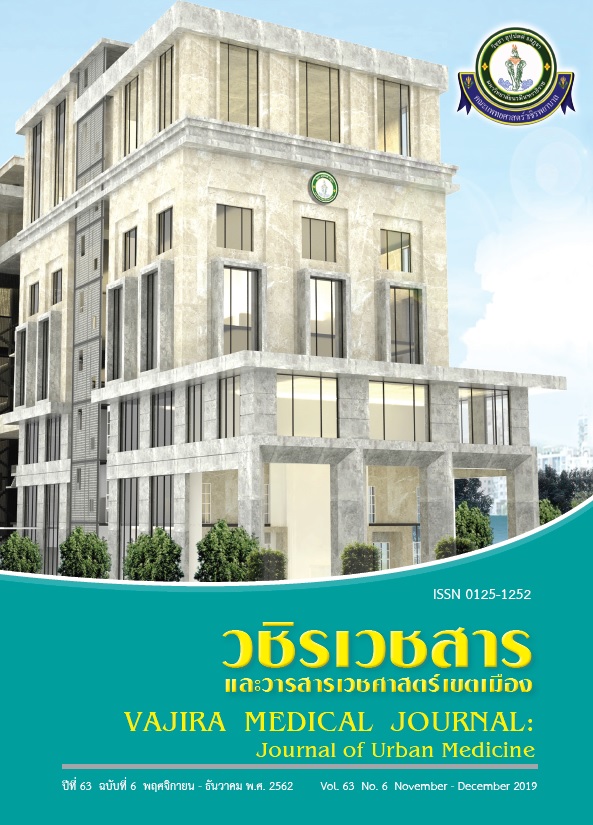Perceived Exercise Behavior in People Who Exercise at Public Parks, Bangkok
Main Article Content
Abstract
Objective: To study Perceived Exercise Behavior in people who exercise at public parks, Bangkok.
Method: This is a survey research. The samples consisted of 206 adults who exercised at public parks in Bangkok. The research tools were the questionnaires which were constructed by the researchers and modified from the Heath Promotion Model concept of Pender et al. (2011). The data were analyzed with percent, mean, standard deviation (SD), t-test and F-test.
Results: The results showed that exercise behavior in people who exercised at public parks, Bangkok were the followings. Most samples preferred running as the type of exercise (64.07%), they had duration of exercise at the parks for 1-6 months (59.22%) and the daily exercise time was 60 minutes (51.94%). Overall perceived exercise behavior was at high level. When classified by catagories, it was found that they had perceived at high level in exercise benefit and self efficacy. The perceived exercise barrier was at moderate level. The variables of gender, age, education, income and family status showed no statistically significant differences in perceived exercise behavior while occupation had statistically significant differences in perception of exercise behavior (p<0.05).
Conclusion: Overall the people who exercised at public parks, Bangkok had perceived exercise behavior was at high level. They had perception at high level in exercise benefit and self efficacy. The perceived exercise barrier was at moderate level.
Downloads
Article Details
References
World Health Organization (WHO) 2018. Noncommunicable diseases. [internet][cited 2019 February13]. Available from: https://www.who.int/news-room/fact-sheets/detail/noncommunicable-diseases.
Sakolsatayadorn P. Thai People die with NCDs, 37 people per hour. Accelerate-prevent and control complications. [internet] [cited 2019 February 10]. Available from: https://www.hfocus.org/content/2018/08/16157).
Siriphanich B. Exercise for Health. [internet] [cited 2019 February 19]. Available from https://sonpinong.blogspot.com/2010/12/blog-post.html.
National Statistic Office. Survey on Population Behavior in Playing Sport or Psychology and Mental Health 2011. Ministry of information and Communication Technology;2012.
5. Pender NJ, Murdaugh CL,Parsons MA. Health promotion in nursing practice (6 th ed.).Pearson:Boston;2011.
Palitnonkiat A, Suebwiset P, Kannang O, Srisouy K, Madta R, Boonrod W. et al., Factors Related to Exercise Behavior of Physical Therapy Students in Huachiew Chalermprakiet University. HCU. Journal 2019; 21(42): 55-63.
Yamsri T, Toonsiri T, Leelukkanaveera Y. Factors Predicting Exercise Behaviors among Nursing Students in Boromarajonani College of Nursing, The North Eastern Region Network Journal of Nursing and Health Care 2018; 35(2):158-67.
Ponpa W, Kaidit A. Predictors for Exercise Behaviors among Health Personnel in Songkhla Province. The Southern College Network Journal of Nursing and Public Health 2018; 4(April):180-95.
Pattaradech C. Perceived Benefits and Attitude Towards Exercise among Older Adults in Songkhla: Prediction Factors. The Southern College Network Journal of Nursing and Public Health 2018; 3(1):158-73.
Panta P, Weiangkham D. The Relationship between Personal Factors, Perceived Benefits Physical Activity and Perceived Barriers Physical Activity, with Physical Activity of Older Adults in Phayao Province. Journal of Health Science & Research 2011; 5(1):7-16.
Cohen, J. A power primer. Psychonlogical Bulletin 1992; 112(1): 155-9.
Division of Physical Activity & Health Exercise for health. Department of Health. Ministry of Public Health. [internet] [cited 2019 February13]. Available from: https://www.thaincd.com/document/file/download/powerpoint/6.การออกกำลังกายเพื่อสุขภาพ.pdf.
Kantharatanakun W. Exercercise in Working Age. Facalty of Medicine Ramathibodi Hospital Mahidol University;2018.
Sirikunchayanon C. Exercercise for Health. Department of Nutrition Faculty of Health Sciences Mahidol University. [internet] [cited 2019 January 9]. Available from: https://www.acn.ac.th/articles/mod/forum/discuss.php?d=243.
Phu Khok Sung C. Physical Education Program, Faculty of Education Exercise for visual enjoyment.[internet] [cited 2019 January 9]. Available from:https://program.npru.ac.th/pe/Exercise for Health (AT).html.
Kasivitumnouy N, Sujarityakul A, Chamnankit P. The Effectiveness of Counseling to realize the Benefits of Exercise, Exercise behavior and Factors associate with Diabetes Patients. Disease Control Journal 2014; 40(4): 349-50.


